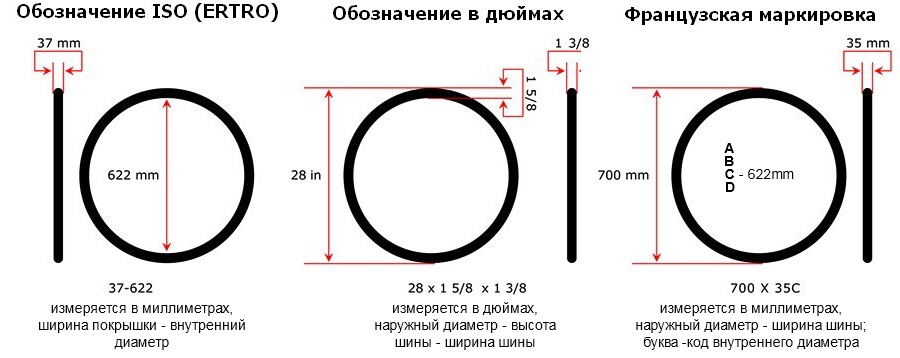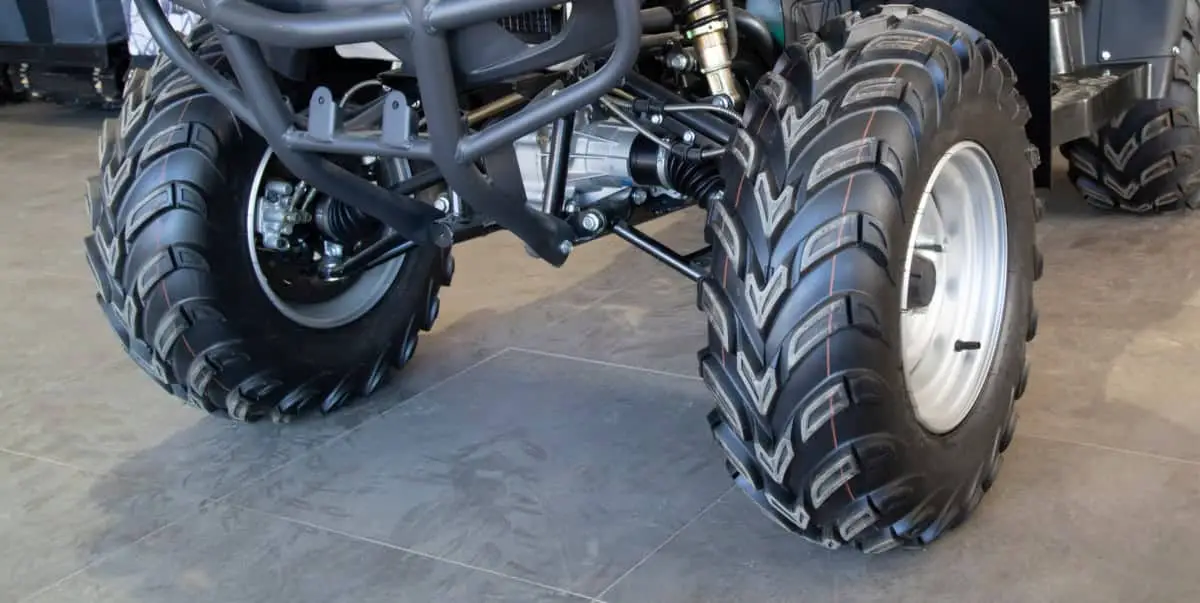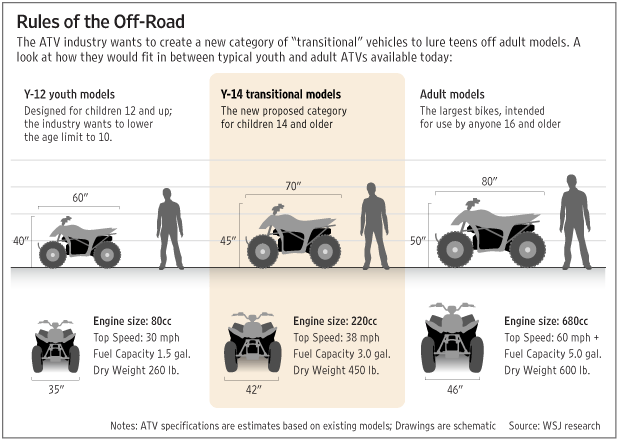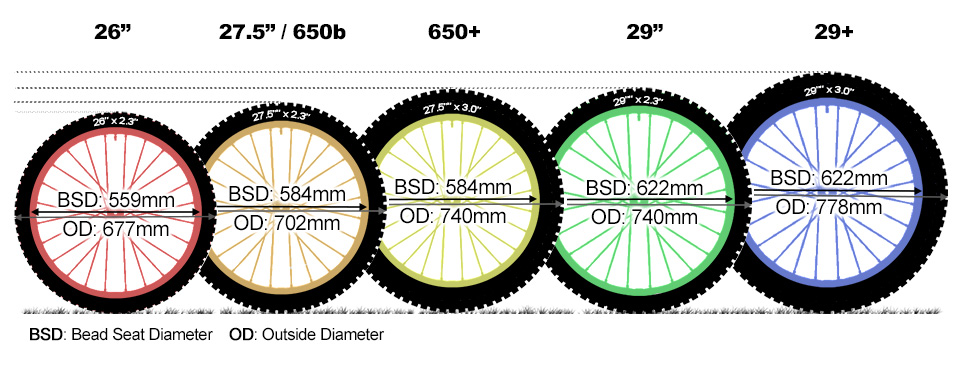Looking up a good set of wheels for recently purchased brand new ATV or used vehicle may seem like an impossible task, especially when wheels are one of the most important parts on your ATV. You need to be confident that you have the right wheels in the correct size, perfectly fitted to your vehicle to be fully immersed in the ATV world. Read this article to learn about ATV wheel sizing, wheel offset, and bolt pattern. So what do all those numbers mean?
While ATV wheels may be constructed of several materials (steel, aluminum), they all are commonly described by three sets of numbers. Let's take this one wheel example - 12x7, 4+3, 4/156.
The first set of numbers in our example, "12x7" is wheel diameter and width of the wheel. Wheel diameter (12 inches) is the widest point across the center from bead seat to bead seat. The width of the wheel (7 inches) is the distance from the outside of the wheel to the inside or vice versa.
First of all, the offset is the distance from the centerline of the wheel to the hub mounting surface. The example wheel has a 4+3 offset. The first number "4" (it means 4 inches) is the distance from the centerline to the inside bead seat. The "3" (3 inches) is the distance from the centerline of the wheel to the outside bead seat (the side with the valve stem hole). The sum of these two distances is 7 inches - the width of our example wheel.
There are three different types of offsets: zero offset, negative and positive. A positive offset is when the inside section (bell) is wider than the outside section (nose) of the wheel. The example wheel has a positive 4+3 offset. If the nose section of the wheel is the widest (3+4 as en example), a wheel has a negative offset. A zero offset is when the hub mounting surface is in the true center of the wheel (4+4 would be a zero offset ATV wheel).
Your ATV already has hubs with one style of the bolt pattern. It may be a 3-lug, 4-lug, or a 5-lug pattern. Besides, each bolt pattern comes in different sizes. So, it is very important to know the correct measurements of the bolt pattern which your ATV has before buying a set of new wheels. Let's take a look at our example size. The last section contains "4/156". It also can be written as "4 on 156mm". The number "4" stands for the number of bolt holes. In this case, we have a 4-lug bolt pattern. The "156" is a distance in millimeters from the center of one bolt hole across the center of the wheel to opposite bolt. The spacing of bolt holes also can be described as the diameter of a virtual circle passing through the center of all bolt holes.
It may be a 3-lug, 4-lug, or a 5-lug pattern. Besides, each bolt pattern comes in different sizes. So, it is very important to know the correct measurements of the bolt pattern which your ATV has before buying a set of new wheels. Let's take a look at our example size. The last section contains "4/156". It also can be written as "4 on 156mm". The number "4" stands for the number of bolt holes. In this case, we have a 4-lug bolt pattern. The "156" is a distance in millimeters from the center of one bolt hole across the center of the wheel to opposite bolt. The spacing of bolt holes also can be described as the diameter of a virtual circle passing through the center of all bolt holes.
Visual illustration for understanding ATV wheel sizes.
Summary
12x7 - The wheel diameter x the width of the wheel
4+3 - The offset of the wheel
4/156 - The bolt pattern of the wheel
Share with friends!
Your quad is a do-anything machine. ATV’s are great for getting things done and for recreation too. But now you’re looking at your tires. Maybe you’ve blown one or they’re getting bald. Or maybe you just want a more aggressive tread pattern and a bigger tire. The problem is you’re a little lost when it comes to your ATV tire size.
ATV’s are great for getting things done and for recreation too. But now you’re looking at your tires. Maybe you’ve blown one or they’re getting bald. Or maybe you just want a more aggressive tread pattern and a bigger tire. The problem is you’re a little lost when it comes to your ATV tire size.
How big can you go? Should you go big? How do you even know what all these numbers represent?
Don’t worry, we’ve got you covered. We’ll answer all those answers and more in this comprehensive guide.
How Do You Read ATV Tire Sizes?So, you’re shopping around for tires and you see one listed with a size like 26×10-12. Or, worse yet, you find something listed like 206/80R12.
What the heck does all that mean?
First, you need to figure out if you’re dealing with standard or metric ATV tire sizes.
ATV Tire Sizes: Standard Tire Sizing ChartStandard format is much more common on ATV tires than metric. You might see a tire size written 26×10-12 or, occasionally, 26x10x12. This format is pretty straightforward. It uses three numbers to sum up the size:
This format is pretty straightforward. It uses three numbers to sum up the size:
If you see a tire size that looks like this: 205/80R12, you know you’re dealing with metric. The metric format is exceedingly rare for ATVs and odds are you’ll never come across it. But if you do, the letter thrown in the middle of those numbers is a dead giveaway. In metric, you always have three numbers and a letter:
There may be other numbers and letters before and after these, but they’re not important for understanding your ATV tire size.
Breaking Down ATV Tire Sizes by the NumbersKnowing how to read those tire sizes is just the first step. You really need to know how to use them. Is 26 inches a reasonable diameter for your quad? What kind of width do you need?
You really need to know how to use them. Is 26 inches a reasonable diameter for your quad? What kind of width do you need?
When you’re considering replacing all of your tires, you’ll want to make sure you get something that will actually fit on your stock vehicle.
Your typical ATV tire diameter fits within a range of about 20 inches for the smallest machines to about 30 inches for your more factory mud-equipped machines.
Basically, your quad will typically fit into one of few categories:
Keep in mind that you’ll want to keep within a couple inches of your stock tire size. If you go too big, you’ll start to rub on your fenders (among other issues). If you go small—well, that’s just silly.
Tire width is easier to understand. Choosing the right tire width has a lot to do with your own preferences and riding style.
A wider tire tends to give you a flatter tread pattern and more grip. A narrow tire gives you a little more control.
ATV’s usually have a wider tire on the rear than on the front to get the best of both tires. A typical rear tire on a quad will be 10 to 11 inches wide while a front tire will be 7 to 8 inches wide.
But matching your tire width to your riding style isn’t the only thing you need to consider. You also need to make sure it’ll physically fit on your chosen wheel. There are two main ways to make sure it’ll fit.
This one is non-negotiable. You have to make sure your tire’s wheel diameter matches your actual wheel diameter.
You have to make sure your tire’s wheel diameter matches your actual wheel diameter.
Most off-road wheels tend to be 10 to 12 inches in diameter—which is convenient considering most off-road tires are designed to fit those wheels. That’s a good size as it gives your tire plenty of cushion between the tread and rim, which results in smoother rides and more protection for your rims.
Of course, you can end up with bigger wheels if you have bigger tires, but we’re getting ahead of ourselves.
Choosing the Right Size Tires for Your ATVYou don’t need any old tire. You have to choose the perfect ATV tire size for you. After all, you ride your own way and have your own needs.
We’re going to simplify ride style to three main types:
For a workhorse ATV, it’s not a bad idea to stick with stock. It’ll give you the expected traction and power you need.
Trail riding, like dune riding, means you want to go fast. For that, a wider, flatter tire will keep you gripping and in control. If you ride in the mud, you might want to go with something bigger and narrower along with an aggressive tread pattern.
For that, a wider, flatter tire will keep you gripping and in control. If you ride in the mud, you might want to go with something bigger and narrower along with an aggressive tread pattern.Trails and dunes demand high traction, and you get that by going wider. You don’t necessarily need a taller tire, but a wider one will give you the grip you need.
Dominating rock gardens and taking on bounty holes is done best with a big tire. But going big isn’t as simple as just buying the biggest tire you see.
Can I Put Bigger Tires on My ATV?The short answer is yes.
Here comes the long answer.
Every ATV has a theoretical maximum tire size it can fit without modifying the suspension. It’s typically about one to two inches bigger than your stock tires. So if your ATV came with a 27-inch tire, you could probably fit a 29-inch tire without too much trouble.
But what if you want to go bigger?
That takes some work. You’ll either need to invest in a lift kit or some offset A-arms. These types of kits will often tell you what the max tire size is when you have them installed.
These types of kits will often tell you what the max tire size is when you have them installed.
You can’t go big without some consequences though. Namely, you’ll lose torque due to the increased diameter (big tires like a high-gear kit!) and the extra weight. The weight can also put extra strain on your clutch and shorten the life of your clutch belt.
Luckily, you can get your torque back with a transmission gear reduction or GDP Portal Gear Lift (which has a gear reduction built in).
You can also bolster your clutch with heavy-duty drive belts and eek out even more torque with a clutch kit.
So now that you’re equipped with knowledge, go equip yourself with some tires. Get the ATV tire size you want, and ride with confidence.
RELATED CONTENT: ATVs38 tires15
Share
10
 sportek.in.ua
sportek.in.ua Nikolaev bicycle shop "Sportek"
Published: 04/07/2017
Edited: 07/15/2018
From time to time the question arises: “What is the diameter of the bicycle wheels?”
Most often, it pops up if a tire has broken through or new tires are needed for the wheel of an old bicycle. And to the seller’s question “What wheel does your bike have?” Only one answer comes to mind: “round”. nine0003
First of all, you need to define the concept of wheel diameter .
For most ordinary people, this is the diameter of the wheel at the outer (outer) border of the tire.
But there is also the concept of rim fit size - this is the diameter of the rim or tire itself along the inner border.
Therefore, it would be a good idea to first understand the tire marking systems adopted in the world in order to speak the same language with the bike shop salesperson. You can read about this in the article "Bicycle tires: sizes, marking types and interchangeability" on our website. nine0003
You can read about this in the article "Bicycle tires: sizes, marking types and interchangeability" on our website. nine0003
For the sake of brevity, here is a figure explaining what is measured in each labeling system. Therefore, it is important to understand what we measure and what we want to find.
When choosing a new rubber, be guided by it. If there is no tire with exactly the same marking, look at the interchangeability table and select the right size in another marking. nine0003
If a new tire is needed a little wider or narrower, check the tire and rim width chart.
If in doubt, talk to the salesperson. He will tell you if it is right for you, both in terms of size, tread, riding style and what kind of roads you want to ride.
This can be done by measuring the radius and multiplying it by two.
For younger students reading this article, I remind you that one diameter consists of two radii.
Only you need to measure strictly from the center of the sleeve, and not from its edges. When measuring, the bike should stand vertically, and the tape measure, putting one end to the ground, keep the same strictly vertically, and not along the spokes of the wheel . Only such a measurement will give the correct value.
The wheel diameter itself can be measured in the same way. The main thing is to accurately determine its upper cut. To do this, you can take a level and attach it to the top of the tire, and, holding it strictly horizontally, determine the desired size from the tape measure.
The main thing is to accurately determine its upper cut. To do this, you can take a level and attach it to the top of the tire, and, holding it strictly horizontally, determine the desired size from the tape measure.
After that, we convert it from mm to inches. To do this, divide it by 25.4 (1 inch = 25.4 mm) and calculate the size in inches. The result can be rounded up to standard inch wheel sizes. nine0003
For example, if the measurement is 720 mm, divide by 25.4 to get 28.346 inches. So, most likely, the actual size of the wheel, taking into account the accuracy of the calculations, is 28”.
In principle, the rim diameter can also be measured in the same way.
Just pay attention to the difference between what is measured on the outside of the tape measure and the fit size of the rim.
And knowing it, it is easy to calculate the diameter. To do this, the circumference in millimeters must be divided by the number "Pi" (3.14). Once you get the diameter in mm, divide it by 25.4 to get the diameter in inches. Similarly to the previous paragraph, the result will have to be rounded to the nearest whole number in inches. The more accurate all measurements, the more accurate the result and the less rounding. nine0003
Comments (2)
Pressure in wheels
The most common ATV tire marking is based on the inch "English" measurement system, consisting of three main numbers.
For example: "25 x 8.5-14". In this case, the first number indicates the height of the tire, the second - its width, the third - the internal fit size on the wheel rim.
ATV tires can be roughly divided into two main categories:
Universal tires have a relatively low tread pattern, allowing them to confidently move at a fairly high speed on even surfaces (asphalt, concrete slabs, etc.), as well as in light off-road conditions. These models, in particular, include:
"DEESTONE D936 Mud Crusher" - has a special V-shaped directional tread pattern, is made from a rubber compound of a special composition with an integrated multilayer cord carcass
"CST Stag CU58" - also available with a directional pattern that provides reliable stability and maneuverability of the machine on any section of normal roads and light off-road
9017 Important! All-terrain ("mud") tires are mainly used for continuous driving in severe off-road conditions.